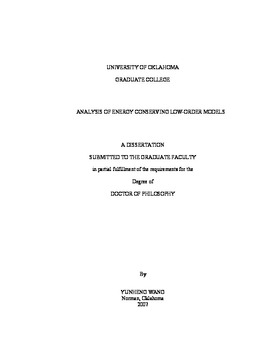| dc.contributor.advisor | Lakshmivarahan, S., | en_US |
| dc.contributor.advisor | Xue, Ming, | en_US |
| dc.contributor.author | Wang, Yunheng. | en_US |
| dc.date.accessioned | 2013-08-16T12:21:01Z | |
| dc.date.available | 2013-08-16T12:21:01Z | |
| dc.date.issued | 2007 | en_US |
| dc.identifier.uri | https://hdl.handle.net/11244/1304 | |
| dc.description.abstract | It is well known in Mathematical Physics that the Volterra gyrostat and many of its special cases including the Euler gyroscope represent a prototype of energy conserving dynamical systems. It is formally proved in this dissertation that the systems of coupled Volterra gyrostats are special cases of LOMs that satisfies the new sufficient conditions. We also introduce the definition of the generalized Volterra gyrostats that contains nonlinear feedback. Exploiting the inherent relation between the energy conserving LOMs satisfying the sufficient conditions and the systems of coupled generalized Volterra gyrostats, it turns out that these two sets of systems are equivalent. Using the class of generalized Volterra gyrostats as basic building block, any energy conserving low-order model that routinely arise in fluid dynamics, turbulence and atmospheric sciences can be converted into a system of coupled generalized gyrostats. An algorithm for doing such a transformation is provided. | en_US |
| dc.description.abstract | Low-order models of order n, denoted by LOM( n), naturally arise in the application of Galerkin type projection techniques to a system of partial differential equations of interest in geophysical domain. In order for the LOM(n) to represent physically meaningful solution, it is necessary that LOM(n) conserves energy. The Galerkin projection technique does not incorporate any explicit criteria for the choice of the order and the modes to guarantee energy conservation. With this study, we derive a new set of sufficient conditions on the structural parameter of LOM(n) for conserving energy. | en_US |
| dc.description.abstract | Motivated by the importance and the central role played by the Volterra gyrostat in studying LOMs, this study also analyze the stability properties of the classical Volterra gyrostat and all of its special cases. | en_US |
| dc.format.extent | xi, 157 leaves : | en_US |
| dc.subject | Energy conservation Mathematical models. | en_US |
| dc.subject | Computer Science. | en_US |
| dc.subject | Galerkin methods. | en_US |
| dc.subject | Atmospheric Sciences. | en_US |
| dc.subject | Fluid dynamics Mathematical models. | en_US |
| dc.subject | Mathematics. | en_US |
| dc.title | Analysis of energy conserving low-order models. | en_US |
| dc.type | Thesis | en_US |
| dc.thesis.degree | Ph.D. | en_US |
| dc.thesis.degreeDiscipline | School of Computer Science | en_US |
| dc.note | Source: Dissertation Abstracts International, Volume: 69-01, Section: B, page: 0443. | en_US |
| dc.note | Advisers: S. Lakshmivarahan; Ming Xue. | en_US |
| ou.identifier | (UMI)AAI3291937 | en_US |
| ou.group | College of Engineering::School of Computer Science | |
